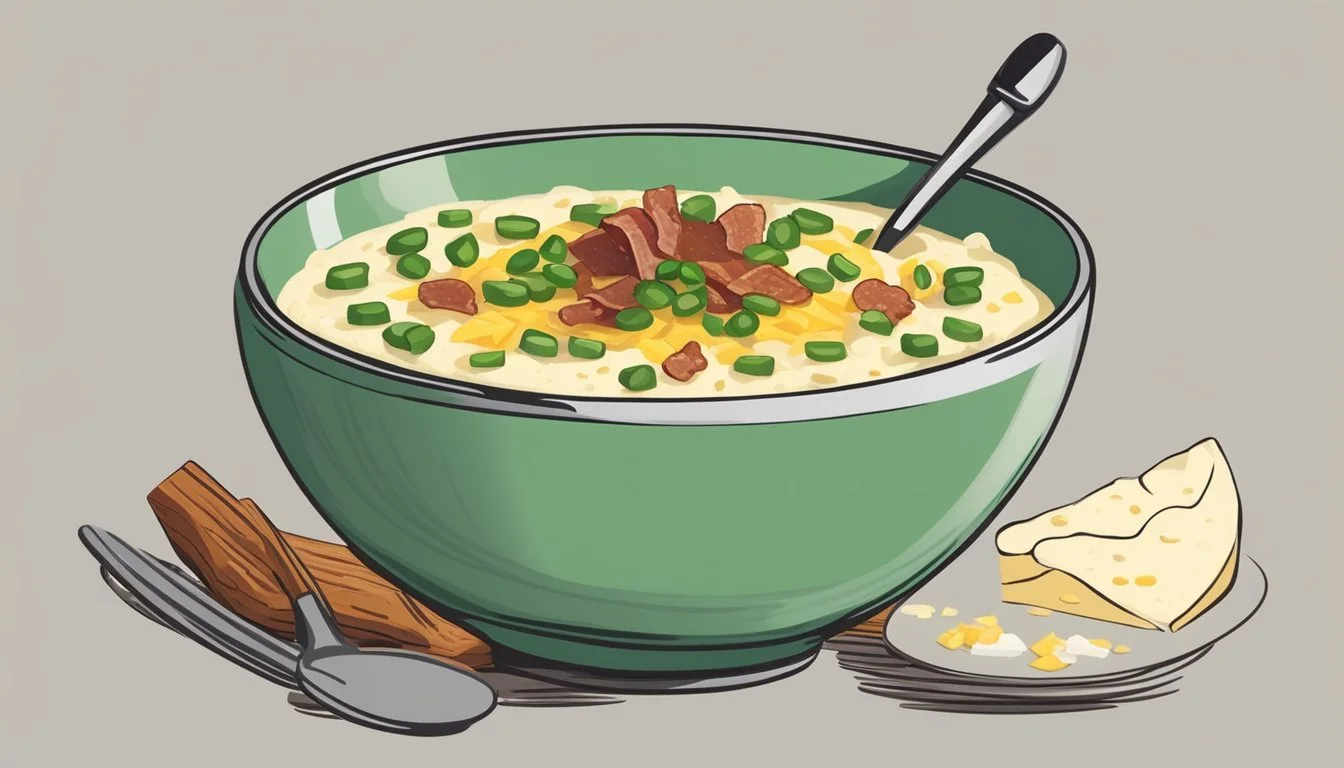How Do You Eat Grits?
Simple Ways to Enjoy This Southern Staple
Grits are a versatile southern staple made from ground corn (how long does corn last?), and they have become a beloved dish across various cuisines for their adaptability and straightforward preparation. Corn is ground into a coarse meal and then cooked into a creamy consistency. Often compared to Italian polenta, grits serve as a canvas for a myriad of flavors and can be enjoyed at any meal. Whether served sweet with a sprinkle of sugar and butter for breakfast or savory with cheese and herbs for dinner, grits offer a comforting meal base.
The preparation of grits involves simmering the dried corn in water, milk, or a blend of both, to achieve the desired creaminess. This process can take anywhere from 15 minutes for quick grits to upwards of an hour for the stone-ground variety, which retains more of the corn's natural flavor and texture. Ensuring that the grits are consistently stirred can help in achieving a smooth, lump-free dish.
Many enjoy their grits cooked simply with a touch of butter and salt, while others enhance the dish with various toppings such as cheese, bacon, or shrimp. (What wine goes well with shrimp?) The dish’s neutral taste allows it to be an accompaniment to a wide array of ingredients, catering to differing palates. Whether served as a primary component of a dish or as a side, grits remain a comforting classic with the potential for creative culinary expression.
What Are Grits?
Grits are a traditional Southern American dish that originate from ground corn and are commonly consumed as a starchy side or breakfast item.
Historical Significance
Historically, grits hail from Native American cuisine, where they began as a corn porridge. They are notably made from hominy—corn kernels that have been treated with an alkali process to remove the hull. Through milling and grinding, these treated kernels are then turned into the familiar coarsely ground product known as grits. This staple food has deep roots in Southern traditions and represents a significant aspect of the region's cultural gastronomy.
Types and Varieties
There are primarily two types of grits: stone-ground and instant. Stone-ground grits are produced by crushing dried corn kernels between stone wheels, which retain more of the corn's flavor and nutritional value. Instant grits have been further processed to reduce cooking time and usually have a finer texture. Grits come from various types of corn, predominantly from dent corn, with color variants being yellow corn and white corn. The differences in color reflect the type of corn used, and while the taste difference is subtle, some may discern variations in sweetness and texture.
Nutritional Profile
Grits offer a range of nutrients, including vitamins, minerals, and antioxidants. A serving of grits can be a good source of iron and folate. The presence of fiber can aid in digestion, although it varies depending on the type; stone-ground grits have more fiber than instant varieties. Grits also provide some proteins and calories that contribute to a balanced diet. Specific nutrients like lutein and zeaxanthin are present in corn and may help in eye health, although these are more concentrated in the corn kernel rather than in processed grits.
Preparing Grits
Preparing grits correctly is essential for achieving the perfect texture and flavor. This section will guide you through basic cooking techniques, the correct water to grits ratios, and how to maintain a creamy consistency through stirring.
Basic Cooking Techniques
One begins by bringing the liquid of choice, which could be water, broth, or milk, to a boil. Grits are then poured slowly into the boiling liquid while stirring gently. Once the grits are incorporated, reduce the heat to a low simmer. This method ensures the grits cook evenly and absorb the liquid without clumps forming.
Water to Grits Ratios
The standard ratio for cooking grits is four parts liquid to one part grits. Here is a simple table for common serving sizes:
Grits (cups) Water/Broth/Milk (cups) 1 4 1/2 2 1/4 1
When a creamier texture is desired, substituting water with milk or adding cream towards the end of cooking can enhance the richness.
Stirring and Consistency
Stirring is a critical step to prevent grits from sticking to the bottom of the pot and to achieve a creamy consistency. Stir the grits frequently with a wooden spoon, especially during the first few minutes of cooking. As they thicken, more gentle stirring is sufficient. The cooking process usually takes about 20 to 30 minutes, depending on the type of grits—stone-ground varieties may take longer.
During cooking, if the grits become too thick before they are fully tender, additional liquid can be added to adjust the consistency.
Grits Dishes
Grits, a versatile Southern staple made from ground corn, can be enjoyed in numerous ways depending on the time of day and flavor preference. They can be transformed for breakfast, savory meals, or sweet indulgences.
Classic Breakfast Grits
For many, Breakfast Grits are the quintessential start to the day. Traditional breakfast grits are usually served warm and creamy, often enhanced with a pat of butter for richness and mixed with cheese for flavor. A breakfast bowl might feature grits as a substantial base, topped with bacon or a protein of choice such as shrimp for a savory edge.
Ingredients:
1 cup of grits
3 cups of water
Butter
Cheese (optional)
Salt to taste
Savory Grits Creations
Savory Grits are enjoyed as a main dish or side, often included in a grits casserole or topped with seafood like in the popular dish, Shrimp and Grits. Here, the smoothness of the grits complements the spices and textures of sautéed shrimp, crispy bacon, and often a mix of colorful vegetables.
Shrimp and Grits:
Serve buttery grits topped with a mixture of sautéed shrimp, bacon, and veggies.
Can be layered with cheese for a cheesy twist.
Sweet Grits Variations
Sweet variations are less common but offer a delightful spin on traditional servings. Sweet Grits might involve a sprinkle of sugar or a drizzle of honey. Fruit can also be added to the dish for natural sweetness and a fresh flavor profile.
Sweetening options:
Sugar
Honey
Fresh fruit such as berries or sliced peaches
By embracing grits' neutral base, chefs and home cooks alike have a broad canvas to create dishes ranging from hearty breakfasts to satisfying main courses and even inventive desserts.
Customizing Your Grits
Customizing grits involves introducing various flavors and textures, as well as incorporating healthy options. Picking the right add-ins can transform the dish from a simple staple to a rich and personalized meal.
Add-Ins for Flavor and Texture
To enhance the taste and texture of grits, one may utilize a range of ingredients that meld well with the dish's naturally soft and creamy consistency. Noteworthy add-ins include:
Fat: To amplify richness, they can mix in butter, which is a classic pairing, or opt for cheeses like cheddar for added depth and creaminess.
Seasonings: For an extra kick, they can incorporate black pepper and salt to taste. Garlic adds aromatic undertones, while cajun seasoning provides a Southern twist.
Texture Enhancers: Introducing a sprinkle of green onions adds both a color pop and a mild crunch. Elements like the hull, germ, and bran — which are removed during grits processing — are not typically reintroduced.
Healthy Toppings and Mix-Ins
Those seeking healthier options without sacrificing flavor have a variety of choices for their grits:
Healthy Fats: Use olive oil instead of butter to contribute monounsaturated fats.
Dairy Alternatives: Try low-fat cheeses or plant-based cheese products to reduce calorie intake while maintaining creaminess.
Seasonings: Enhance flavor without extra calories by using herbs like parsley or spices such as paprika.
Nutrient-Rich Mix-Ins: Incorporating sliced avocado or nuts can bolster the nutrition profile with beneficial fats and vitamins.
By integrating these components thoughtfully, one can create a bowl of grits that is both delicious and tailored to their dietary preferences.
Comparison to Other Foods
In comparing grits to other foods, it's important to assess their nutritional value, especially in terms of fiber content, presence of essential nutrients, and their overall health benefits and considerations.
Grits vs. Oatmeal
Grits, particularly the stone-ground variety, are a traditional Southern dish made from ground corn. Oatmeal, on the other hand, is a staple grain breakfast made from rolled or crushed oats. When looking at their nutritional profiles, oatmeal typically contains more fiber and protein per serving than grits. For example, one cup of cooked oatmeal generally offers around 4 grams of fiber and 6 grams of protein, while one cup of instant grits made with water provides approximately 2 grams of fiber and 3 grams of protein.
Nutrient Grits (per serving) Oatmeal (per serving) Fiber 2g 4g Protein 3g 6g Fortified Iron Present in enriched grits Naturally occurring
Grits vs. Other Corn Dishes
Grits are often considered alongside other corn-based dishes like hominy or polenta. These foods vary in texture and flavor, but grits, particularly stone-ground grits, retain more of the corn kernel, and hence, more nutrients like niacin, thiamin, and riboflavin, compared to more processed varieties like quick grits or instant grits. However, all types of corn dishes can be part of a nutritious diet when prepared with minimal added fats or sugars.
Health Benefits and Considerations
Grits can offer specific health benefits, especially when they are fortified. Enriched grits are often fortified with niacin, thiamin, riboflavin, and iron. A serving of enriched grits may provide 100% of the daily value for iron. However, it's crucial to note the difference between whole-grain stone-ground grits and more processed options like quick and instant grits — the latter tend to have fewer benefits due to lower fiber content and fewer nutrients. Regular consumption of whole-grain foods like old-fashioned or stone-ground grits can contribute to a lower risk of heart disease, helping manage cholesterol levels.
Grits in Different Cultures
Grits have a deep-rooted place in the culinary traditions of the American South and have found variations worldwide as corn porridge.
Grits in the American South
In the American South, grits are a staple, traditionally made from ground, dried corn and mainly served as a side dish. They can range from stone-ground, which is more coarse and retains more of the corn kernel's flavor, to quick and instant grits that have been pre-cooked and dehydrated for convenience. Across the South, grits are often served with butter, cheese, and shrimp, reflecting the region’s agricultural and coastal influences. Cultural significance is attributed to grits in Southern cuisine, as they represent a time-honored tradition that dates back to the Native Americans.
Global Variations of Corn Porridge
Globally, corn porridge appears in many cultures, although it may not always be called grits. For example, Italy has polenta, also a corn-based dish, and in parts of Africa, a similar staple known as mealie-meal is prevalent. The cooking styles differ slightly; polenta is usually a bit coarser than Southern grits and often served with tomato sauce or meats, while mealie-meal is finer and commonly accompanies meat and vegetables or is served with milk and sugar. These dishes share a common ground as comforting, versatile bases capable of being enriched with a variety of flavors and ingredients.
Tips and Tricks for Cooking Grits
Grits can be a delightful and versatile addition to any meal, whether it's for breakfast, as a side dish, or incorporated into a savory entrée. Achieving the perfect consistency and flavor with grits requires attention to detail in the selection of grits, cooking methods, and serving options.
Choosing the Right Type of Grits
Different types of grits offer unique textures and flavors. Stone-ground grits are the most traditional form, milled from whole dried corn kernels, offering a full corn flavor and a creamy texture when cooked properly. Quick grits have been ground finer and processed to reduce cooking time, while instant grits are pre-cooked and dehydrated, requiring only reconstitution with hot water. For optimal taste, one should choose stone-ground grits, although it takes longer to cook.
Cooking Tools and Techniques
Having the right cooking tools can greatly enhance the grits experience. A heavy-bottomed pan distributes heat evenly, which is essential when slow-cooking stone-ground grits to avoid scorching. A whisk is key for stirring, especially during the first few minutes when adding grits to boiling water to prevent lumps from forming. One should cook grits on low to medium heat, stirring occasionally, until they reach a smooth and creamy consistency.
Serving Suggestions
Grits are not only easy to make but also highly adaptable. They can be served as a comforting breakfast dish, perhaps with a pat of butter or a sprinkle of cheese. For a more savory touch, one might incorporate shrimp or top with a fried egg. Grits can also play a sweet note, complemented by sugar, cinnamon, or fruit. Whether choosing a sweet or savory profile, grits serve as a satisfying staple that rounds out the meal.
Grits in Special Diets
Grits can be a suitable option for those on special diets, offering nutritional benefits while also considering gluten-free and allergy needs. They can be integrated into various diets, complementing an array of eating plans.
Gluten-Free and Allergy Considerations
Grits are naturally gluten-free, made from ground corn, which makes them an excellent alternative for individuals with gluten intolerance or celiac disease. However, it is crucial for consumers to check packaging to ensure there was no cross-contamination during processing.
For those with allergies, grits pose a low allergy risk. Unlike other grains, corn is not a common allergen, making grits a safe choice for many. As with gluten-free considerations, individuals should verify that the grits have not been processed in a facility that handles allergens like nuts, soy, or dairy if they are sensitive to these.
Integrating Grits into Various Diets
Grits can be a healthy addition to numerous diet plans, as they provide essential nutrients such as iron and B vitamins, particularly folate. In their whole grain form, they can fit into heart-healthy and diabetic-friendly diets due to their potential to reduce the risk of heart disease and help with blood sugar control.
Heart-Healthy Diets: Grits contain fiber, although less than oats, that can help manage cholesterol levels.
Diabetic Diets: For those managing diabetes, grits should be consumed in moderation, paired with foods high in fiber to minimize blood sugar spikes.
To include grits in various diets, serve them alongside high-fiber vegetables or lean proteins to balance the meal. When prepared without excess butter or sugar, grits can remain a healthy option across these dietary considerations.
Storing and Reusing Grits
Storing grits correctly extends their shelf life, and leftover grits can be creatively repurposed to enhance subsequent meals.
Proper Storage Techniques
Dry Grits: Store in an airtight container in a cool, dry place. They can remain edible for up to a year. For longer shelf life, placing dry grits in the fridge can preserve them for up to three years.
Cooked Grits: Should be placed in the refrigerator within two hours of cooking. Use airtight containers sprayed with non-stick spray to prevent sticking. Refrigerated cooked grits last for 5-7 days.
Freezer Storage:
Ensure cooked grits are cooled.
Portion into freezer-safe containers or heavy-duty freezer bags.
Remove excess air, seal tightly.
Label with date; they're good for up to 6 months.
Repurposing Leftover Grits
Leftovers can be transformed into various dishes:
Grit Cakes:
Chill cooked grits until firm.
Shape into patties and pan-fry until golden.
Serve with a fried egg on top for a hearty breakfast.
It's best to reheat leftovers with a bit of liquid (water, milk, or broth) over a stove or in a microwave, stirring until the desired consistency is reached.
Conclusion
Grits, a staple in Southern American cuisine, offer a versatile and nutritious option for any meal. They can be enjoyed simply with butter and salt or enhanced with a variety of flavors such as cheese, garlic, or even shrimp for a heartier dish. The key to unlocking their full potential lies in proper cooking techniques, from boiling liquid to simmering the grits until they achieve a creamy texture.
Nutritionally, they carry benefits through their content of antioxidants like lutein and zeaxanthin, which support eye health, and they often come enriched with iron and folate—a boon for preventing anemia. While instant varieties provide convenience, opting for stone-ground grits can offer a richer flavor and more fiber.
The cultural significance of grits runs deep, especially in the South, where they're not only a breakfast item but also part of a rich culinary heritage that often accompanies celebration and community gatherings.
Their culinary adaptability ensures that grits can find a place in any diet, from the most straightforward preparations to complex, flavor-layered dishes. As grits continue to find their way into more kitchens across the globe, they bring with them a sense of tradition and the promise of a satisfying, nourishing meal that’s as much about comfort as it is about sustenance.







